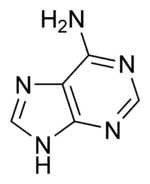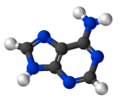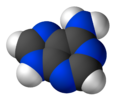Adenine
| Adenine | |
|---|---|
 |
|
 |
 |
|
9H-purin-6-amine
|
|
|
Other names
6-aminopurine
|
|
| Identifiers | |
| CAS number | 73-24-5 |
| PubChem | 190 |
| ChemSpider | 185 |
|
SMILES
n1c(c2c(nc1)ncn2)N
|
|
|
InChI
InChI=1/C5H5N5/c6-4-3-5(9-1-7-3)10-2-8-4/h1-2H,(H3,6,7,8,9,10)
Key: GFFGJBXGBJISGV-UHFFFAOYAT |
|
| Properties | |
| Molecular formula | C5H5N5 |
| Molar mass | 135.13 g/mol |
| Melting point |
360–65 °C |
| Except where noted otherwise, data are given for materials in their standard state (at 25 °C, 100 kPa) |
|
| Infobox references | |
Adenine is a nucleobase (a purine derivative) with a variety of roles in biochemistry including cellular respiration, in the form of both the energy-rich adenosine triphosphate (ATP) and the cofactors nicotinamide adenine dinucleotide (NAD) and flavin adenine dinucleotide (FAD), and protein synthesis, as a chemical component of DNA and RNA.[1] The shape of adenine is complementary to either thymine in DNA or uracil in RNA.
Contents |
Structure
Adenine forms several tautomers, compounds that can be rapidly interconverted and are often considered equivalent.
Biosynthesis
Purine metabolism involves the formation of adenine and guanine. Both adenine and guanine are derived from the nucleotide inosine monophosphate (IMP), which is synthesised on a pre-existing ribosome through a complex pathway using atoms from the amino acids glycine, glutamine, and aspartic acid, as well as fused with the enzyme tetrahydrofolate.
In Saccharomyces cerevisiae (yeast), the adenine pathway converts P-ribosyl-PP into adenine through a seven-step process.
Function
Adenine is one of the two purine nucleobases (the other being guanine) used in forming nucleotides of the nucleic acids. In DNA, adenine binds to thymine via two hydrogen bonds to assist in stabilizing the nucleic acid structures. In RNA, which is used for protein synthesis, adenine binds to uracil.
Adenine forms adenosine, a nucleoside, when attached to ribose, and deoxyadenosine when attached to deoxyribose. It forms adenosine triphosphate (ATP), a nucleotide, when three phosphate groups are added to adenosine. Adenosine triphosphate is used in cellular metabolism as one of the basic methods of transferring chemical energy between chemical reactions.
History
In older literature, adenine was sometimes called Vitamin B4.[2] It is no longer considered a true vitamin or part of the Vitamin B complex. However, two B vitamins, niacin and riboflavin, bind with adenine to form the essential cofactors nicotinamide adenine dinucleotide (NAD) and flavin adenine dinucleotide (FAD), respectively. Hermann Emil Fischer was one of the early scientists to study adenine.
Some think that, at the origin of life on Earth, the first adenine was formed by the polymerization of five hydrogen cyanide (HCN) molecules. However, this has been criticized by some chemists.[3]
References
- ↑ Definition of Adenine from the Genetics Home Reference - National Institutes of Health
- ↑ Vera Reader (1930). "The assay of vitamin B4". Biochem J. 24 (6): 1827–31.. doi:10.1007/BF01581575. PMID 16744538.
- ↑ Shapiro, Robert (June, 1995). "The prebiotic role of adenine: A critical analysis". Origins of Life and Evolution of Biospheres 25: 83–98. doi:10.1007/BF01581575. http://www.springerlink.com/content/ru56122875200030/.
|
|||||||||||||||||||||||||||
|
||||||||||||||||||||||||||||||||||||